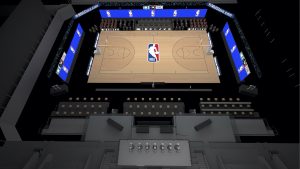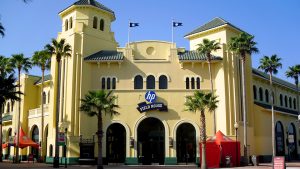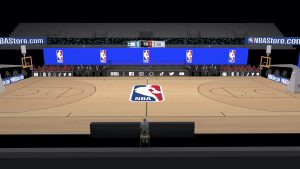NBA Returns: ESPN, Turner, NBA Team Up for Sprawling, COVID-Safe Production at Wide World of Sports
Broadcasts will include national telecasts and world feeds for RSNs
Story Highlights
The long wait is over, and the NBA returns to the hardcourt tonight with a Jazz-Pelicans and Clippers-Lakers doubleheader from the league’s bubble at Disney’s Wide World of Sports (WWoS) complex in Orlando. The pair of telecasts on TNT will tip off one of the largest undertakings in NBA broadcast history with the NBA, ESPN, and Turner Sports teaming up to produce not only national telecasts but also world feeds for hundreds of regional-sports-network broadcasts across the country.
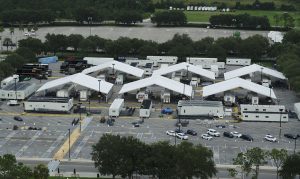
An aerial view of the NBA production compound at ESPN Wide World of Sports. (Photo courtesy of Chris Calcinari/ESPN)
A nearly 200,000-sq.-ft. broadcast compound has been built and follows strict health and safety guidelines, and the three WWoS arenas have been transformed into one-of-a-kind venues chock-full of LED screens, robotic cameras, embedded microphones, and other state-of-the-art tech.
This is a high-level overview of plans for production operations in Orlando. Stay tuned for more in-depth SVG coverage of NBA, ESPN, and Turner Sports operations at the Wide World of Sports in the coming days.
Inside the Compound: A Baker’s Dozen Trucks, Plenty of Safety Measures
The 194,920-sq.-ft. broadcast compound is equal to roughly three football fields and serves as home to 13 production trucks and 31 trailers.
ESPN is using NEP’s EN3 and EN2 mobile units and Game Creek Video’s Victory (all with A and B units). Turner Sports has rolled in NEP’s Supershooter 8, TS2, and M14 (all with A and B units). In addition to the trucks and trailers, the compound features six mobile-unit cover tents, two catering tents, two field-shop tents, and multiple cooling stations.
Powering the compound are 20 generators provided by CAT Entertainment Services: 12 500-kVA units, two 300-kVA units, two 400-kVA tow plants, and four 175-kVA tow plants. Also on hand are 32 HVAC units.
ESPN and Turner have laid more than 436 miles of fiber to tie together the compound, the three arenas, and various areas throughout the WWoS complex.
On the transmission side, there are 65 outbound paths and 14 inbound paths for ESPN, which is relying on The Switch and its ESPNet company-wide infrastructure.
Positions within the trucks have been reorganized to ensure social distancing, with most A units housing just six crew members. Many of the replay operators and robotic-camera shaders have been outboarded to the B unit or other locations in the compound. In addition, ESPN is using its “GREMI” model for all its telecasts, with three or four replay operators and graphics and scorebug positions operating out of its Bristol, CT, headquarters.
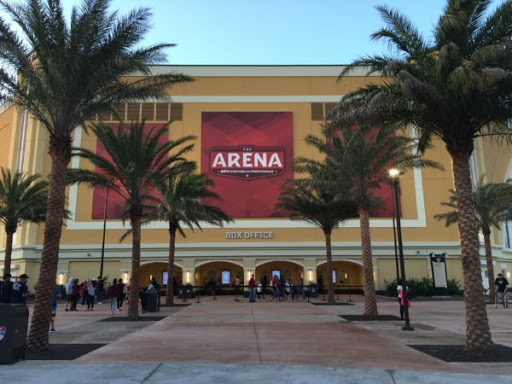
The Arena will serve as Court 1, hosting the Conference Finals and NBA Finals.
The crew has been divided into functional groups, with the majority of the production and operations staff in the “yellow zone” and commuting solely between their hotel on Disney property and WWoS. Individuals are also limited to specific trucks and trailers to minimize cross-contamination among the crew. Crew members are required to wear face masks and maintain social distancing at all times. All onsite staff are tested regularly for COVID-19 and have daily temperature tests upon arrival at the facility.
NBA Entertainment EVP, Media Operations and Technology, Steve Hellmuth is leading the charge for the league’s broadcast plans. The ESPN operations team onsite is led by SVP, Remote Production Operations, Chris Calcinari; Senior Operations Manager Patty Mattero; and Senior Remote Operations Specialist Eddie Okuno. Turner Sports ops are headed by VP, Operations and Technology, Chris Brown.
Inside the Venues: RailCam and Robos Galore
NBA games will be played across three venues at the WWoS: The Arena (Court 1, the main national-telecast court and site of Conference Finals and NBA Finals), HP Fieldhouse (Court 2 for the regular season to Second Round), and the Visa Athletic Center (Court 3, primarily for games broadcast exclusively by RSNs).
RSNs will receive a world feed produced by either ESPN or Turner, along with a dedicated iso camera (with full comms to the camera operator) and access to several other camera feeds. The final telecast will be integrated at the RSN’s home control room/truck.
The mobile units are assigned to one venue apiece: The Arena is covered by EN3 (ESPN) and Supershooter 8 (Turner); HP Fieldhouse, Victory and TS2; and Visa Athletic Center, EN2 and TS2. In addition, ESPN is producing a large chunk of the RSN games from Visa as REMI (remote-integration) shows, sending camera/audio feeds to control rooms in Bristol to be integrated for the final production.
At least 258 cameras have been deployed across the WWoS complex, including more than 60 robos. Each venue is equipped with 30+ cameras for game coverage, with The Arena and HP having roughly the same camera complement and Visa a slightly smaller one.
Chief among the new production elements is the RailCam system at both The Arena and HP Fieldhouse, which will glide along the court at floor level to create a valuable new shot for ESPN and TNT coverage.
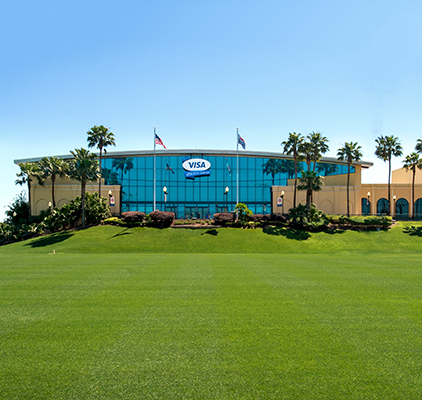
Visa Athletic Center will host the majority of the RSN-exclusive games.
Nearly all court-level cameras, normally manned positions, have been converted to robos. Seven cameras (depending on the venue and the game) continue to be manned: one center-court handheld (the only court-level unit), three up cameras (game, tight, and second tight), left and right slash, and reverse shots.
In addition, a significant number of robotic cameras have been positioned atop, behind, and below the backboards, as well as in locker rooms, hallways, and at practice facilities to capture behind-the-scenes action. The league will take advantage of the lack of fans in the arena by positioning cameras in ways they have never been placed before. Drones are also being used outside the arenas to capture scenic shots from the WWoS campus.
The Audio Factor: Mics in the Floors and on Players and Coaches
A total of 357 microphones have been deployed (119 per court) across the three venues, including 34 microphones embedded in each court to capture sneaker squeaks, player interaction, and other sounds of the game rarely heard with thousands of fans in the arena.
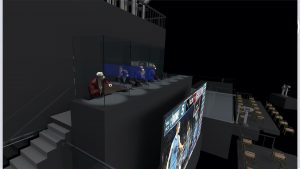
ESPN, TNT, and NBA TV announcers will be higher up than their typical courtside seat and in a plexiglass-separated booth.
Mics will also be deployed around the benches, court, and backboards, and ESPN and Turner plan to mike coaches, players, and referees more often than usual to capture in-game audio. Viewers will also be able to hear refs’ explanations of replay challenges, because the officials will be communicating directly with the scorer’s table (which is behind plexiglass) via an intercom.
The league is handling all in-venue audio and simulated crowd noise with team-specific DJs and PA announcers onsite to re-create the sounds and experiences typically expected at the home team’s arena. Each game will feature home-team audio branding, crowd audio loops based on what the home arena would sound like, and team-specific music. ESPN, Turner, and NBA TV will incorporate the audio into their telecasts as part of the in-arena nat sound (crowd noise will not be directly integrated into the broadcast-audio mix).
As for on-air talent, ESPN, TNT, and NBA TV announcers will be located higher up than their typical courtside seat in a plexiglass-surrounded booth to ensure social distancing. In addition, pregame, in-game, and postgame interviews will be conducted at 6+ ft. with reporter and player having their own microphones.
The In-Venue Look: LED Boards, Fan Integration, Virtual Graphics
With no fans in the stands, the NBA has created a dazzling, LED-fueled environment to surround the court. On three sides of the court will be 17-ft. LED videoboards; an additional videoboard displaying play-by-pay, replays, and stats will be on the fourth side.
The NBA is looking to integrate fans into the in-venue experience via a partnership with Microsoft, allowing them to watch the game live with their fellow fans in what the league is calling “Michelob ULTRA Courtside.” The 17-foot-tall LED screens around three sides of the arena will serve as “stands” displaying with more than 300 cheering fans who will join the game using Together mode in Microsoft Teams. Alongside a view of their fellow fans, participants can watch a live feed of the game within Teams.
Virtual graphics/signage will be used to integrate sponsorship and other content directly on the court, and national broadcasters and RSNs will be able to customize these elements for their respective broadcasts.
During NBA national telecasts, fans will also see Second Spectrum player-tracking graphics and enhanced shot charts.
The NBA season resumes tonight on TNT with Jazz-Pelicans (6:30 p.m. ET) and Clippers-Lakers (9 p.m.). NBA TV tips off at 4 p.m. Friday with Grizzlies-Blazers, followed by ESPN’s Celtics-Bucks (6:30 p.m.) and Rockets-Mavericks (9 p.m.).
